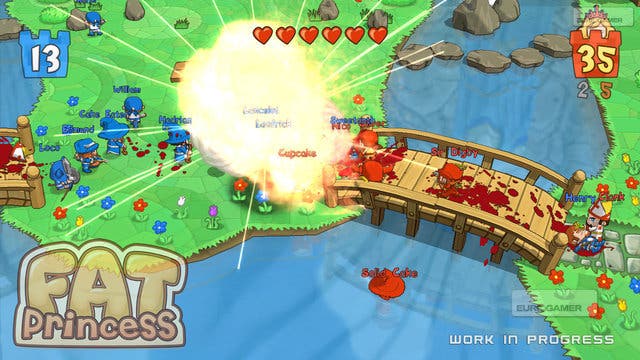Fat Princess
Let her eat cake.
Princesses lose weight over time, so you'll need to keep yours fed to ensure this strategy is effective. But if ferrying pieces of cake backwards and forwards isn't your idea of fun there are 15 other players per team to help out, and there's plenty of other stuff to be getting on with.
You might make it your business to collect wood and metal for upgrading those machines. Or you could take it upon yourself to put on a Priest's hat and help out your team's Warriors. Or, as a nippy Villager, you could pick up a magic potion, run into the heart of the battle and drop it on the ground, turning everyone nearby into chickens - including yourself and your team-mates if you're not careful.
When you first start playing Fat Princess, the temptation is to run around experimenting with all the things you can do. It helps that it's so easy to switch character classes (just walk up to the hat you want and press circle) and that it only takes five seconds to respawn if you die. However after a while you start paying more attention to what your team-mates are doing, and begin to think about the good of the whole.
In the playtest I took part in, no one was using voice chat. It was still possible to work with other players just through observation, but a headset will be required if you want to employ serious tactics. "As people play the game in testing and discover the strategies, they start to come up with their own codenames," says Leigh. "So you'll hear, 'Everybody - operation Eagle Drop!' That means build the catapult, everyone grab bombs and fly into the enemy castle. Or people start forming teams - four Warriors in the front, three Priests in the middle, five Rangers at the back... So as the game is progressing it's getting overt strategies that people learn."

You can just listen to the chat if you don't want to contribute. "If I'm honest, it's incredibly hilarious," Leigh says. "It sounds like you're in Gladiator. People start shouting, "There's ten coming from the north!", guys are screaming, "HOLD THE LINE!", stuff like that."
The more you play, the more you see how people could take such a funny game so seriously. Simple as it is to pick up the controls and understand the principles, there are loads of quirks and neat features which add layers of depth. Each team has a tower, for example, which provides a shortcut into their castle - take control of your enemy's tower while they're focused on keeping you off that bridge, and the dynamic of power instantly shifts.
Then there's in-game rule that "everything works how you expect it to work", as Leigh puts it. If you're on fire, you can jump in the river to put yourself out. If you see someone carrying a bomb you can pull on a Fire Mage's hat, use a blast of lightning to ignite the bomb and blow them up. Fire Mages can melt the blocks created by Ice Mages, and so on.
The point is there's not a lot to learn, but there's a lot to play with. And people to play with, as 32 players can take part in each battle. There's a matchmaking system to ensure beginners can compete with players of their own skill level, along with persistent rankings and leaderboards. Titan has recently added host migration, and if the host (or any other player) quits the match it will continue with their place taken by an AI character.
The AI is key to the single-player game. It's been designed, says Leigh, with the aim of making it indistinguishable from the multiplayer. "The AI is behavioural. Your team-mates will do what needs doing, but they'll also pay attention to you," he explains. "We didn't want to make two games - it's the same game, the same chaos, the same fun, but the AI's helping you instead."

There is an extra element, however, which features only in the single-player. By standing near a character and pressing up on the d-pad, you can instruct him or her to follow you around and help you out. Up to three characters will follow you at a time, so you can create your own team within a team - get a bunch of Workers to help you mine, for example, or lead a couple of Warriors and a Priest into battle. There's a single-player Skirmish mode, which is just for mucking about, and a Story mode designed to teach you the fundamentals of the game in a more formal manner.
But the real attraction of Fat Princess is the multiplayer. Even playing without a headset, it's easy to become invested in your squad's success and feel a strong desire to play your part. Allowing players to be autonomous and switch classes at will, while still being part of a team, creates a fascinating dynamic.
Most importantly, it's fun. It's even fun if your brain thinks it's in a different time zone, and even if you haven't eaten for six hours. And especially if you'd rather kill yourself than listen to one more person tell you how his game about killing Nazis/zombies/drug dealers/drug dealing Nazi zombies is "unique".
Fat Princess may combine familiar elements but it really is unique. You can tell that within a couple of hours, even with plenty still to discover. "We're still learning things and we've been playing it for a year," says Leigh. "It's a really unique mixture of gameplay elements, but they all fit together so well... Like a cake, I guess." Tasty.

